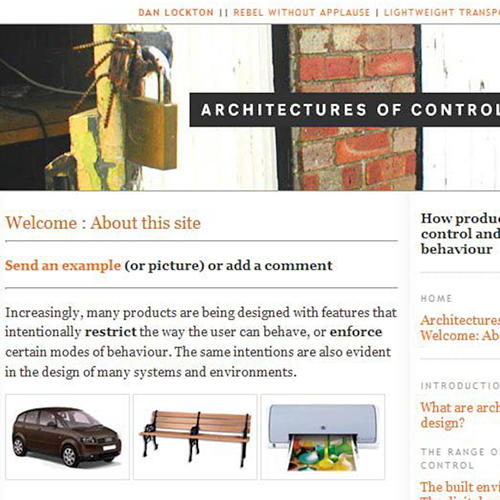All posts by “danlockton”

Getting someone to do things in a particular order (Part 3)
Continued from part 2 This series is looking at what design techniques/mechanisms are applicable to guiding a user to follow a process or path, performing actions in a specified sequence. The techniques fall roughly into three ‘approaches’. In this post, I’m going to examine the […]

The Rebound Effect nicely illustrated
The Rebound Effect is a significant problem in energy policy and sustainable design: if new devices are more energy efficient, will users simply use them more, or leave them on for longer? (A kind of Jevons’ Paradox). This UK Energy Research Centre report (PDF, 5 […]

Cyclepathology
A lot of architectures of control / design with intent examples are trying to enforce what I’ve termed ‘access, use or occupation based on user characteristics’. Not all designs are especially successful at achieving that target behaviour: users will not always be persuaded, or will […]

Seminar, 27th May
I’ll be giving a brief seminar at Brunel on Tuesday 27th May, in advance of presenting at Persuasive 2008 – it’s a bit of a practice/rehearsal, to be honest…

links for 2008-05-20
Berkeley Path Gallery More ‘desire paths’ – thanks to Ariel Guersenzvaig (http://interacciones.org ) for the tip (tags: desirepaths Berkeley architecturesofcontrol, desire paths interaction use usemark) Metaverse Territories Mixed realities (tags: metaverse SecondLife architecture architecturesofcontrol, design reality) CFP: The Psychology of Facebook This looks to be […]

Ann Thorpe: Can artefacts be activists?
Ann Thorpe, author of the intriguing-sounding Designer’s Atlas of Sustainability – is pursuing an interesting investigation into design activism: Some of the basic issues around design activism include: # isn’t all design activism? # how much design should be activist — aren’t designers supposed to […]

Best bitter
Bitrex, the world’s most bitter substance, is what’s known as a taste aversive – added to products which might seem tasty to humans (especially children) to persuade them not to drink them, or to spit out what they’ve already drunk. It’s a similar idea to […]

One-way turn of the screw
One-way screws, such as the above (image from Designing Against Vandalism, ed. Jane Sykes, The Design Council, London, 1979) are an interesting alternative to the usual array of tamper-proof ‘security fasteners’ (which usually require a special tool to fit and remove). There’s a very interesting […]

links for 2008-05-28
Cities and Ambition “I’d always considered ambition a good thing, but I realize now that was because I’d always implicitly understood it to mean ambition in the areas I cared about. When you list everything ambitious people are ambitious about, it’s not so pretty.” (tags: […]

User-Centred Design for Sustainable Behaviour
TU Delft’s Renee Wever and Jasper van Kuijk (who runs the insightful Uselog product usability blog), together with NTNU’s Casper Boks, have produced a very interesting paper, ‘User-Centred Design for Sustainable Behaviour’ [PDF, 400 kb] for the International Journal of Sustainable Engineering (indeed, probably in […]


